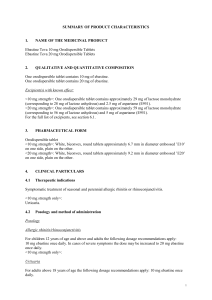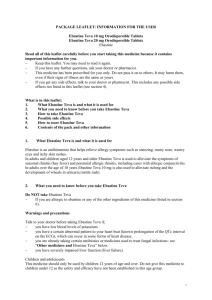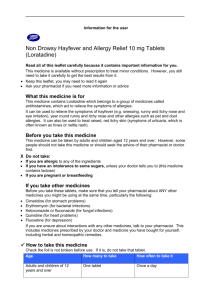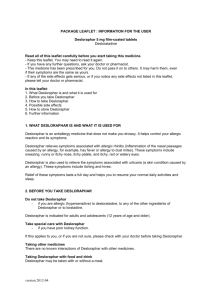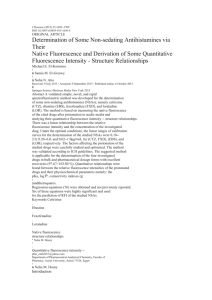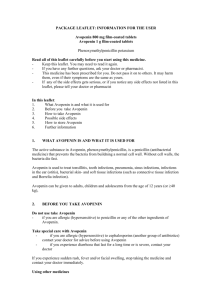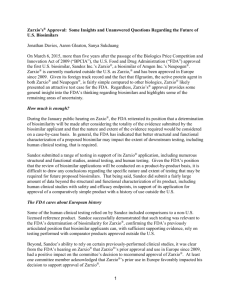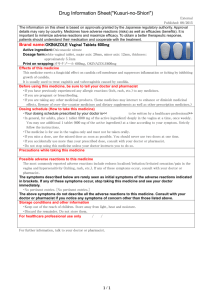3. How to take Ebastine Sandoz
advertisement
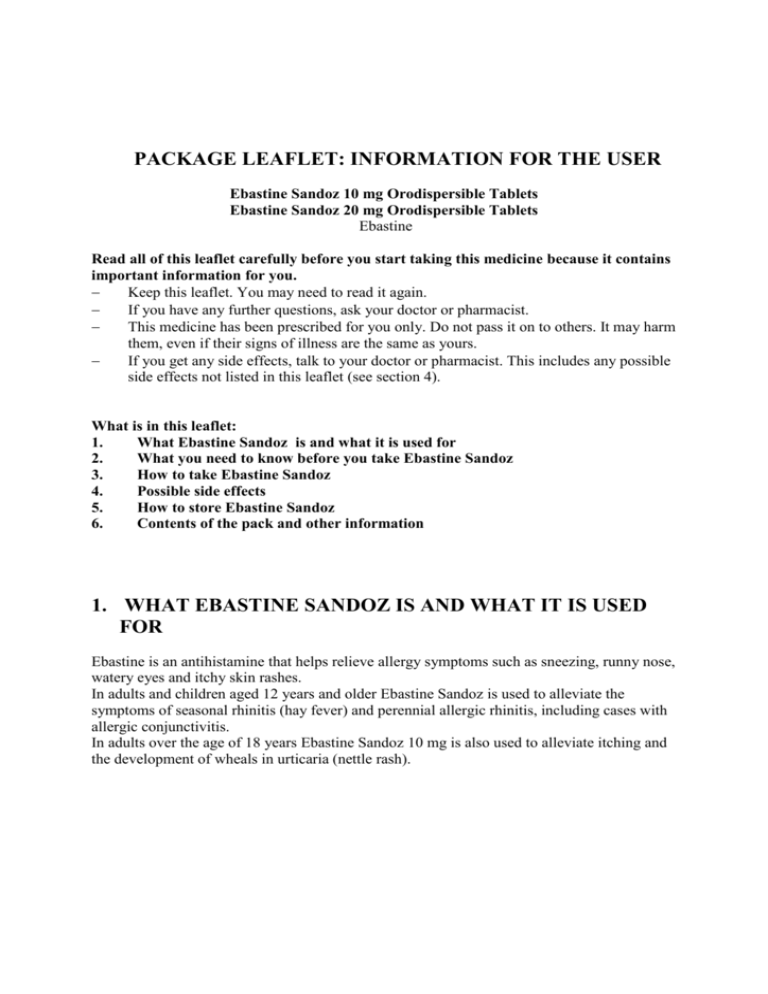
PACKAGE LEAFLET: INFORMATION FOR THE USER Ebastine Sandoz 10 mg Orodispersible Tablets Ebastine Sandoz 20 mg Orodispersible Tablets Ebastine Read all of this leaflet carefully before you start taking this medicine because it contains important information for you. Keep this leaflet. You may need to read it again. If you have any further questions, ask your doctor or pharmacist. This medicine has been prescribed for you only. Do not pass it on to others. It may harm them, even if their signs of illness are the same as yours. If you get any side effects, talk to your doctor or pharmacist. This includes any possible side effects not listed in this leaflet (see section 4). What is in this leaflet: 1. What Ebastine Sandoz is and what it is used for 2. What you need to know before you take Ebastine Sandoz 3. How to take Ebastine Sandoz 4. Possible side effects 5. How to store Ebastine Sandoz 6. Contents of the pack and other information 1. WHAT EBASTINE SANDOZ IS AND WHAT IT IS USED FOR Ebastine is an antihistamine that helps relieve allergy symptoms such as sneezing, runny nose, watery eyes and itchy skin rashes. In adults and children aged 12 years and older Ebastine Sandoz is used to alleviate the symptoms of seasonal rhinitis (hay fever) and perennial allergic rhinitis, including cases with allergic conjunctivitis. In adults over the age of 18 years Ebastine Sandoz 10 mg is also used to alleviate itching and the development of wheals in urticaria (nettle rash). 2. WHAT YOU NEED TO KNOW BEFORE YOU TAKE EBASTINE SANDOZ Do NOT take Ebastine Sandoz If you are allergic to ebastine or any of the other ingredients of this medicine (listed in section 6). Warnings and precautions Talk to your doctor before taking Ebastine Sandoz if; you have low blood levels of potassium. you are already taking certain antibiotics or medicines used to treat fungal infections: see “Other medicines and Ebastine Sandoz” below. you have severely impaired liver function (liver failure). Children and adolescents This medicine should only be used by children 12 years of age and over. Do not give this medicine to children under 12 as the safety and efficacy have not been established in this age group. Other medicines and Ebastine Sandoz Tell your doctor or pharmacist if you are taking, have recently taken or might take any other medicines. Taking Ebastine Sandoz and erythromycin (antibiotic) or ketoconazole, itraconazole (active substances for the treatment of fungal infections) at the same time can lead to higher blood levels of ebastine. Concomitant administration of ebastine with rifampicin (antituberculosis agent) can result in lower blood levels of ebastin and therefore reduced effects.Using Ebastine Sandoz at the same time as clarithromycin or josamycin (antibiotics) is not recommended. Ebastine Sandoz with food and drink You may take Ebastine Sandoz independently from meal times. Pregnancy ,breast-feeding and fertility There is limited experience to date of the safety in humans for the unborn child. For this reason, you should take Ebastine Sandoz during pregnancy only if your doctor considers that the expected benefit outweighs the possible risks. Do not take Ebastine Sandoz if you are breast-feeding an infant, as it is not known whether the active substance passes into mother’s milk. If you are pregnant or breast-feeding, think you may be pregnant or are planning to have a baby, ask your doctor or pharmacist for advice before taking this medicine. Driving and using machines Most patients treated with Ebastine Sandoz may drive or carry out other activities that require a good reaction capacity. As with all other medicines, however, you should check your individual reaction after taking Ebastine Sandoz before you drive or carry out complicated activities, some patients experience sleepiness or dizziness. Ebastine Sandoz contains Lactose: if you have been told by your doctor that you have intolerance to some sugars, contact your doctor before taking Ebastine Sandoz Aspartame (E951), a source of phenylalanine, and may be harmful for people with phenylketonuria. 3. HOW TO TAKE EBASTINE SANDOZ Always take Ebastine Sandoz exactly as your doctor or pharmacist has told you. Check with your doctor or pharmacist if you are not sure. The recommended dose is: Indication Allergic rhinitis Age Children 12 years and above and adults In case of severe symptoms Nettle rash (urticaria) Adults above 18 years of age Dose One Ebastine Sandoz 10 mg tablet (10 mg ebastine) daily Two Ebastine Sandoz 10 mg tablet or one Ebastine Sandoz 20 mg tablet (20 mg ebastine) once daily One Ebastine Sandoz 10 mg tablet (10 mg ebastine) once daily In patients with impaired kidney function, no dose adjustment is necessary. In patients with mild to moderately impaired liver function, no dose adjustment is necessary. There is no experience with doses over 10 mg in patients with severe hepatic insufficiency; therefore the dose should not exceed 10 mg in these patients. Do not push the tablet out of the pocket, as this will crush it. Each strip contains tablets separated in pockets by perforations. Tear off one tablet pocket along the dotted lines (Figure 1) Carefully peel off the lidding foil, starting in the corner indicated by the arrow (Figures 2 and 3) Keep your hands dry and take the tablet out of the strip. Place the tablet on your tongue where it will disperse within seconds: no water or other fluid is required. You may take Ebastine Sandoz independently of meal times. Your doctor will decide on the duration of use. If you take more Ebastine Sandoz than you should There is no special antidote for the active substance ebastine. If you suspect an overdose with Ebastine Sandoz, please tell your doctor. Depending on the severity of the intoxication, he/she will initiate the appropriate measures (monitoring of vital body functions, including ECG monitoring for at least 24 hours, symptomatic treatment and gastric lavage), if necessary. If you forget to take Ebastine Sandoz Do not take a double dose to make up for a forgotten dose. If you have any further questions on the use of this product, ask your doctor or pharmacist. 4. POSSIBLE SIDE EFFECTS Like all medicines, this medicine can cause side effects, although not everybody gets them. Stop taking Ebastine Sandoz and contact your doctor immediately or go to the nearest hospital if the following happens: Serious allergic reaction causing itching and swelling of the face, tongue or throat which may cause difficulty in swallowing or breathing. Severe allergic reactions to Ebastine Sandoz are rare (they may affect up to 1 in 1,000 people). Other side effects include: Very common side effects may affect more than 1 in 10 people Headache Common side effects may affect up to 1 in 10 people: Drowsiness Dry mouth Uncommon side effects may affect up to 1 in 100 people Sore throat (pharyngitis), runny nose (rhinitis), nose bleeds Rare side effects may affect up to 1 in 1,000 people Nervousness, insomnia Dizziness, diminished sense of touch, taste disturbances Palpitations, accelerated pulse Abdominal pain, vomiting, nausea, indigestion Inflammation of the liver (hepatitis), problems with the elimination of bile(cholestasis), abnormal liver function test Rash, nettle rash, inflammation of the skin Menstrual disorders Oedema (accumulation of water in the tissues), weakness (asthenia) Very rare side effects may affect up to 1 in 10,000 people Disturbed sense of touch Wide spread rash, eczema Painful menstruation Reporting of side effects If you get any side effects, talk to your doctor. This includes any possible side effects not listed in this leaflet.You can also report side effects directly (see details below). By reporting side effects you can help provide more information on the safety of this medicine. [To be completed nationally] 5. HOW TO STORE EBASTINE SANDOZ Keep this medicine out of the sight and reach of children. Do not use this medicine after the expiry date which is stated on the blister and carton after ‘EXP’. The expiry date refers to the last day of that month. Store in the original package in order to protect from light. Do not throw away any medicine via wastewater or household waste. Ask your pharmacist how to throw away medicines you no longer use. These measures will help to protect the environment. 6. CONTENTS OF THE PACK AND OTHER INFORMATION What Ebastine Sandoz contains The active substance is ebastine. Each orodispersible tablet contains 10 mg ebastine. Each orodispersible tablet contains 20 mg ebastine. The other ingredients are cellulose microcrystalline, lactose monohydrate, maize starch, croscarmellose sodium, aspartame (E951), peppermint flavour, silica colloidal anhydrous and magnesium stearate. What Ebastine Sandoz looks like and contents of the pack Orodispersible tablet Ebastine 10 mg: White, biconvex, round tablets embossed ’E10’ on one side, plain on the other. Ebastine 20 mg: White, biconvex, round tablets embossed ’E20’ on one side, plain on the other. Available in pack sizes of: 10 mg: 10, 20, 30, 40, 50, 90, 98 and 100 orodispersible tablets. 20 mg: 10, 15, 20, 30, 40, 50, 98 and 100 orodispersible tablets Not all pack sizes may be marketed. Marketing Authorisation Holder and Manufacturer <To be completed nationally> This medicinal product is authorised in the Member States under the following names: [Name of Member States] [Name of the medicinal product] This leaflet was last revised in 2015-12-10
